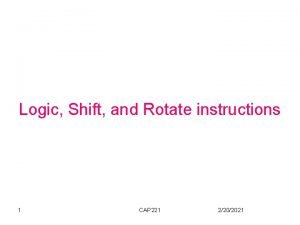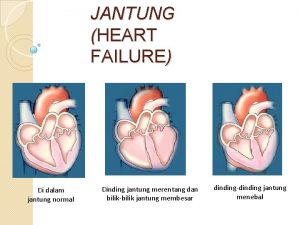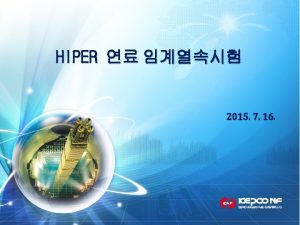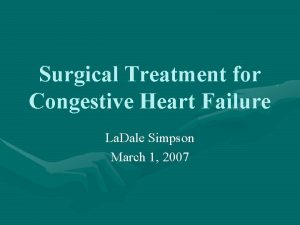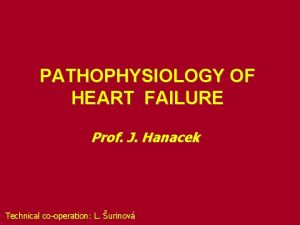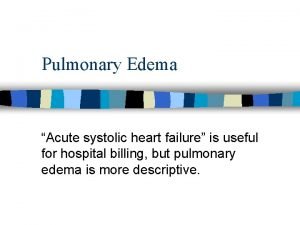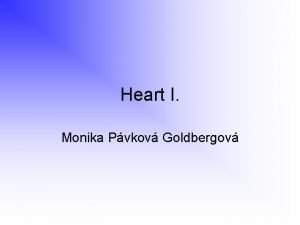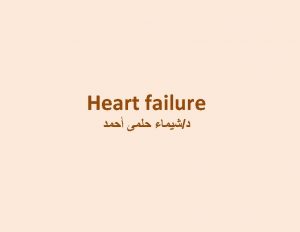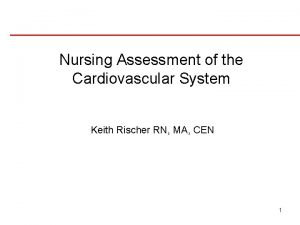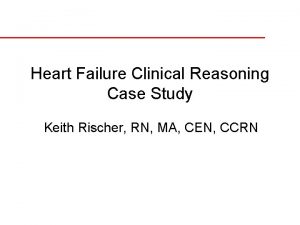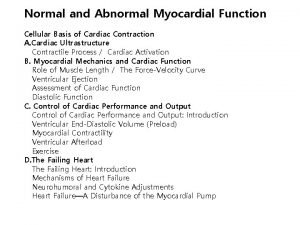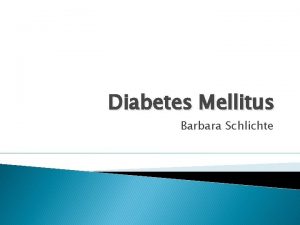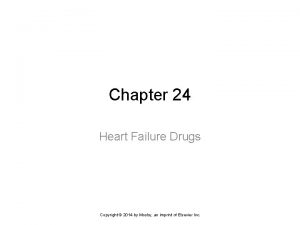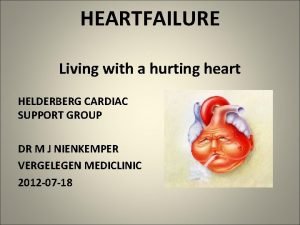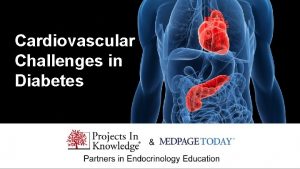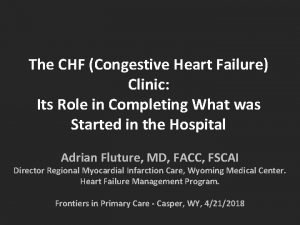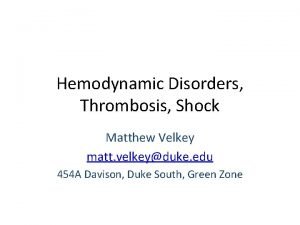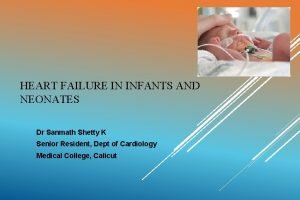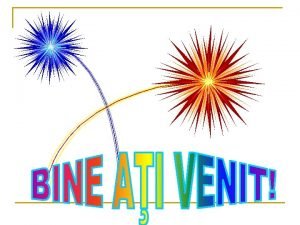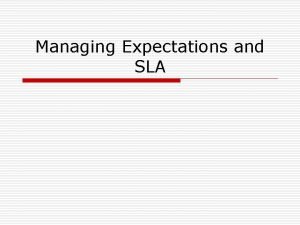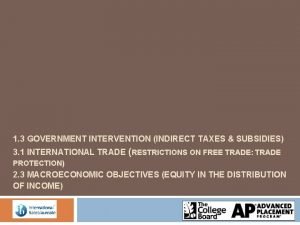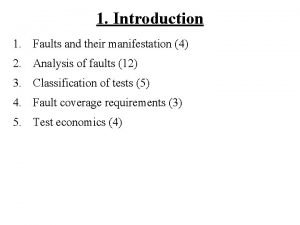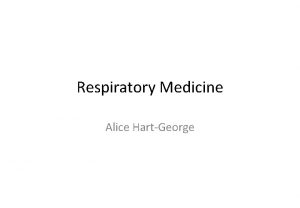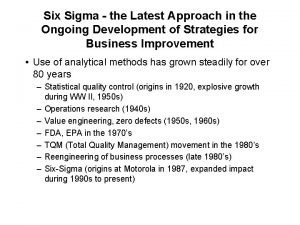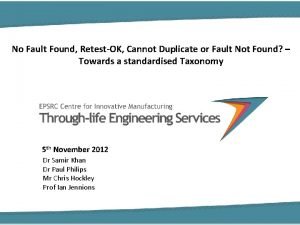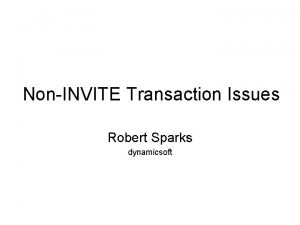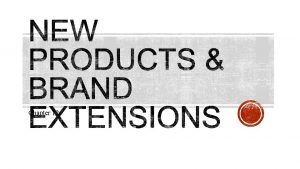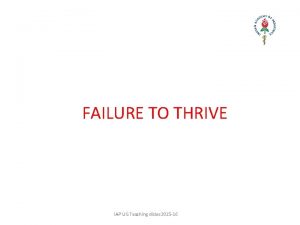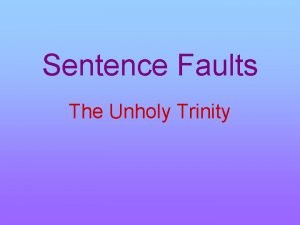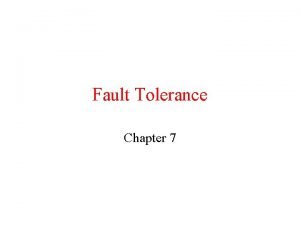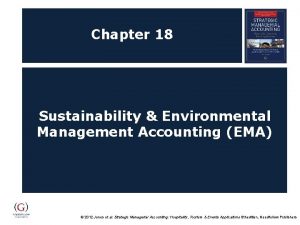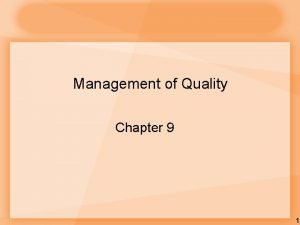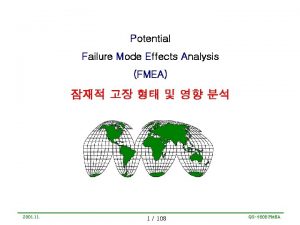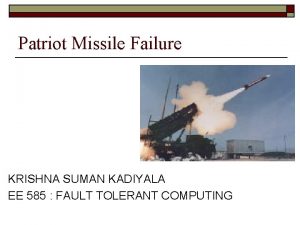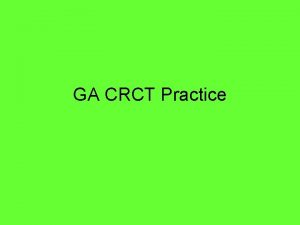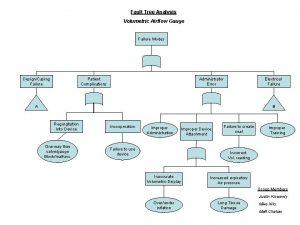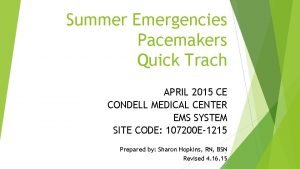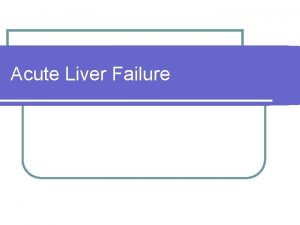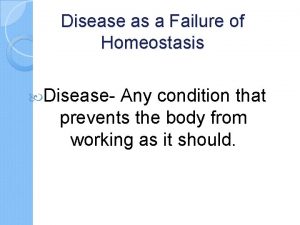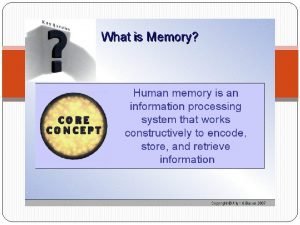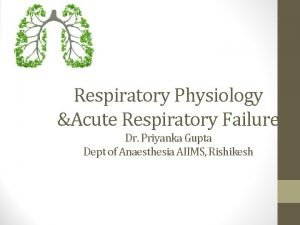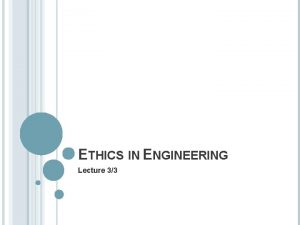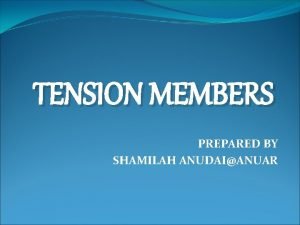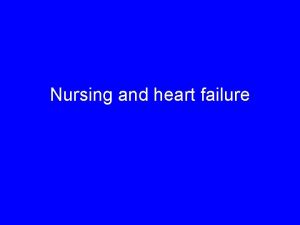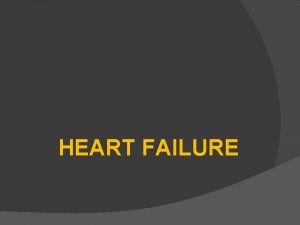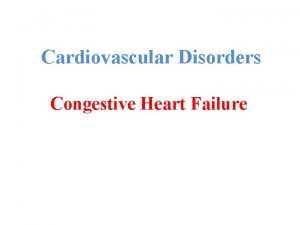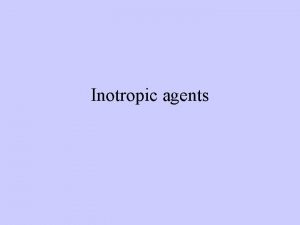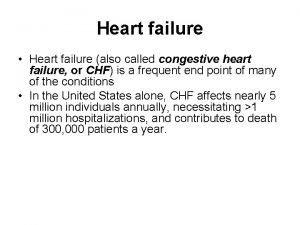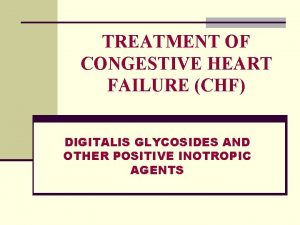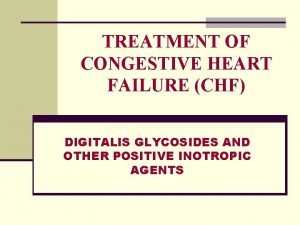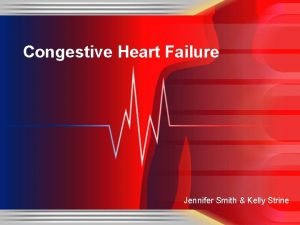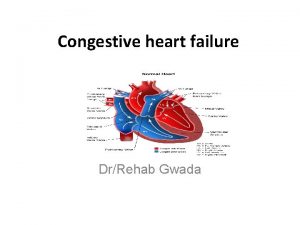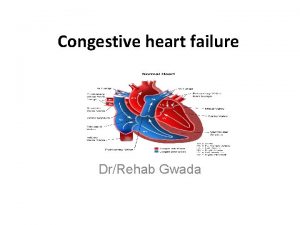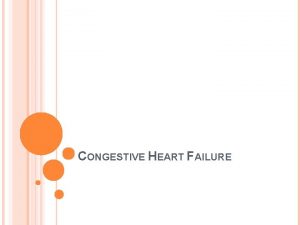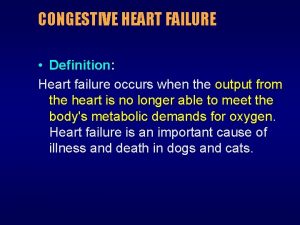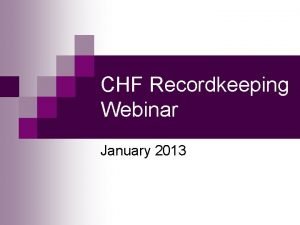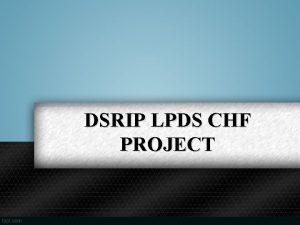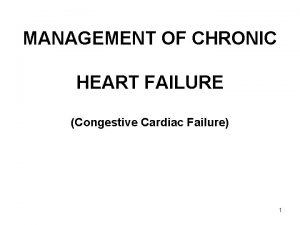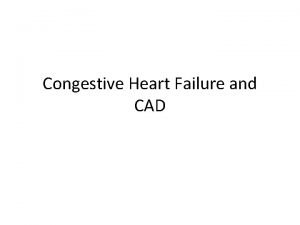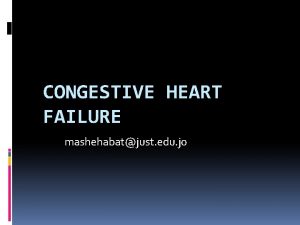Congestive heart failure Congestive heart failure CHF It



































































- Slides: 67

Congestive heart failure

Congestive heart failure (CHF) • It is a condition in which the heart is unable to pump sufficient amount of blood to meet the metabolic demands of the body • It is a syndrome with multiple causes that may involve the - right ventricle - left ventricle - both ventricles

The ventricular dysfunction may be primarily • Systolic - inadequate force generation to eject blood normally - ↓ CO EF ↓ 45% - typical of acute failure especially resulting from myocardial infarction (MI) • Diastolic - inadequate relaxation to permit normal filling - CO, EF may be normal - result of hypertrophy & stiffening of myocardium - does not respond to +ve ionotrophic drugs

High output failure: • Demands of the body are so great that even ↑↑ CO is insufficient eg. beri hyperthyroidism anemia arteriovenus shunts • Respond poorly to +ve ionotrophic drugs • Cause should be treated

↓↓ FC Heart failure ↓↓ CO ↓↓ renal perfusion ↓↓ carotid sinus firing ↑↑ sympathetic discharge ↑↑ renin release ventricular dilatation vasoconstriction ß 1 activation ↑ preload ↑ afterload ↑ FC ↑ HR ↓↓ GFR AT-1 ↑ AT-2 ↑ preload ↑ afterload ↑ aldosterone CARDIAC REMODELLING BACK PRESSURE pulmonary congestion dyspnea & cyanosis EDEMA HEPATIC CONGESTION ENLARGED LIVER ANOREXIA peripheral congestion Na & H 2 O retention

• The therapeutic goal in the management of heart failure is to ↑↑ the cardiac output

Drugs used in heart failure 1) Drugs with positive ionotrophic effects a) Cardiac glycosides – digoxin, digitoxin, oubain b) Phosphodiesterase inhibitors – inamrinone, milrinone c) ß adrenergic agonists – dopamine, dobutamine

2) Drugs without positive ionotrophic effects a) Diuretics – furosemide, hydrochlorthiazide b) ACE inhibitors – enalapril c) ß blockers – carvedilol, bisoprolol, metoprolol d) Vasodilators – hydrallazine, Na nitroprusside

Cardiac glycosides (cardenolides)

Cardiac glycosides • If a sugar molecule is joined together with a nonsugar molecule by an ether linkage it is called a glycoside sugar ether non-sugar glycoside link Digitoxose X steroidal cardiac lactone glycoside • Pharmacological activity – non-sugar moiety • Pharmacokinetic properties – sugar part

• Digitalis lanata (leaves) – 2 active principles digoxin, digitoxin • Digitalis purpurea (foxglove) - digitoxin

Mechanism of action

• The force of contraction of the cardiac muscle is directly related to the concentration of free cytosolic Ca 2+ • Any drug that increases free cytosolic Ca 2+ levels ↑↑ force of contraction sensitivity of contractile mechanisms to Ca 2+

• Ca 2+ initially enter through voltage sensitive L-type of Ca 2+ • • • channels It triggers the release of larger quantity of Ca 2+ from the sarcoplasmic reticulum (SR) by activating SR- Ca 2+ release – ryanodine receptor The ↑↑ Ca 2+ concentration initiates the contractile process During restorative process of periodic contractions Ca 2+ ions are removed by re-uptake into SR by SR- Ca 2+ ATPase It is also extruded by a Na+/ Ca 2+ pump exchange pump Intracellular Na+ balance is then restored by Na+/K+/ATPase pump


• Mechanism of action:

• Digitalis binds to & reversibly inhibits cardiac cell membrane associated Na+/K+/ATPase • Progressive accumulation of intracellular Na+ and loss of intracellular K+ • ↑↑ intracellular Na+ concentration prompts diversion Na+ ions to the Na+/ Ca 2+ exchange mechanisms • This exchanger normally extrudes Ca 2+ in exchange for Na+ • In the presence of ↑↑ intracellular Na+ concentration it extrudes Na+ in exchange for extracellular Ca 2+ • There is also an ↑↑ in Ca 2+ permeability through voltage sensitive L channels during plateau phase • Digitalis also inhibits SR- Ca 2+ ATPase & reduces reuptake of Ca 2+ by SR

• Ultimately ↑↑↑ cytosolic Ca 2+ triggers contractile mechanisms of failing heart ↑↑ cardiac output • Higher serum K+ concentration inhibits digitalis binding to Na+/K+/ATPase - hyperkalemia can ↓ digitalis toxicity - hypokalemia ↑↑ risk of digitalis toxicity Hypercalcemia ↑↑ risk of digitalis Hypomagnesemia induced arrhythmias

Pharmacological actions Cardiovascular system (CVS) • In normal individuals no significant variation - ↑↑ force of contraction - ↑↑ cardiac output Also ↑↑ peripheral resistance affect ↑↑ venous pressure nullified • Heart rate unchanged

• Contractility In heart failure - ↑↑ force of contraction ↑↑ stroke volume complete emptying of heart Diastolic size of heart ↓↓ ↓↓ O 2 consumption for work output i. e ↑↑ work done for ↓↓ O 2 consumption & ↓↓ energy Hence, known as cardiotonic drug

Heart rate • It decreases heart rate by - direct Na+/K+/ATPase inhibition - ↓ sympathetic activity - indirect vagal stimulation Conduction velocity • Irrespective of the dose it - ↓↓ conduction velocity - ↑↑ ERP of the AV node & purkinje fibres by - vagal action - extravagal action (Na+/K+/ATPase) • This protects the ventricles from - atrial flutter - atrial fibrillation

• In relatively smaller doses it ↑↑ conduction velocity ↓↓ ERP of atrial muscles • High doses – ↑↑ automaticity contractility ↓↓ ERP of atria & ventricles causing - extrasystoles - pulsus bigeminus - ventricular fibrillation • As the cholinergic innervation is only upto the AV node – vagal effects of digitalis are more pronounced at - the AV node & atria - than on purkinje system or ventricles

• • • Blood vessels In normal people it has direct vasoconstrictor effect In heart failure compensatory sympathetic over activity removed – ↓↓ in heart rate ↓↓ in peripheral resistance ↓↓ in preload Blood pressure No prominent effect Coronary circulation Improvement secondary to ↑↑ in CO & ↓↓ in heart rate Venous system ↓↓ in venous pressure secondary to improvement in circulation In CHF ↓↓ venous tone ↑↑ peripheral blood flow

• Extra cardiac effects Kidney • Diuresis occurs due to improvement in renal perfusion which brings edematous fluid into circulation • It occurs due to – - ↓↓ sympathetic activity - ↓↓ renin angiotensin aldosterone system - ↓↓ aldosterone - ↓↓ Na & H 2 O retention GIT • Anorexia, nausea, vomiting CNS • Disorientation, hallucinations, visual disturbances

Kinetics • The safety margin of cardiac glycosides is very narrow • Minor variations in bioavailability therapeutic failure toxicity

• • • Digoxin Fairly well absorbed orally (40 -60%) Half life – 38 -40 days Eliminated largely by the kidney Digitoxin Absorbed rapidly & completely Half life 6 -7 days Metabolized in the liver Excreted via bile into the gut Entero-hepatic circulation is present Can be used in renal failure

ADRs • • Cardiac side effects Bradycardia Partial or complete heart block Atrial & ventricular extrasystoles Pulsus bigeminy (coupled beats) Ventricular fibrillation Fatal cardiac arrhythmias If cardiac arrhythmias develop Ca 2+ Mg 2+ & K+ states should be corrected

Treatment of digitalis toxicity • Brief cases of bigeminy – - oral K+ supplementation - withdrawal of digoxin • Serious arrhythmias - parenteral K+ - lignocaine • Ventricular fibrillation (digitalis induced) cardioversion • Ventricular & supraventricular tachycardia - propranolol (if AV block not ++)

• Severe digitalis intoxication (with depressed automaticity) - anti-arrhythmatic drugs fatal - Digiband Fab fragments - digitalis antibodies • Such patients can be saved by administration of these antibodies • They are extremely useful in reversing severe intoxication

Extra cardiac ADRs • GIT - anorexia, nausea, vomiting, diarrhea, abdominal cramps • CNS - headache, fatigue, neuralgias, blurred vision, loss of color perception • Endocrinal - gynaecomastia

• • • Drug interactions: Loop diuretics Thiazides ↓↓ K+ levels Corticosteroids Ca salts synergistic action Catecholamines cause Succinylcholine arrhythmias Amiodarone Quinidine displace Verapamil digitalis from Tetracyclines protein binding Erythromycin E N H A N C E D D I G I T A L I S T O X I C I T Y

• • Digitalis effects ↓↓ by Antacids Sucralfate ↓↓ absorption Neomycin Enzyme inducers Phenobarbitone ↑↑ metabolism Phenytoin ↓↓ entero-hepatic Cholestyramine circulation Hyperthyroidism ↑↑ renal clearance

Uses • Congestive heart failure • Paroxysmal supra-ventricular tachycardia • Atrial flutter & atrial fibrillation

Phosphodiesterase inhibitors • Amrinone • Milrinone • Levosimendon

Mechanism of action • These drugs inhibit the enzyme phosphodiesterase isoenzyme III which is specially located in cardiac myocytes & vascular smooth muscle • They prevent degradation of c. AMP ↑↑ contractility (heart) ↑↑ vasodilatation (blood vessels)

• They also have direct vasodilating effect • They also ↑↑ inward Ca 2+ influx during action potential • In patients of CHF they - ↑↑ CO - ↓↓ pulmonary wedge pressure - ↓↓ PR

• • • Kinetics They are administered in loading dose by intravenous (IV) infusion Followed by slow maintenance infusions in saline They are unstable in dextrose Fluid balance potential problem & drawback in CHF patients Toxicities also limit their use

• • • Amrinone Toxicity - nausea, vomiting Dose dependent thrombocytopenia Arrhythmias – ventricular rate ↑↑ in patients of atrial flutter & atrial fibrillation Milrinone Safer than amrinone Arrhythmias ↑↑ incidence Renal impairment - ↑↑ plasma half life

ß 1 adrenergic agonists • ß 1 adrenergic stimulation improves cardiac performance by +ve ionotropic effects • They cause an ↑↑ in intracellular c. AMP activation of protein kinases phosphorylation of slow Ca channels ↑↑ Ca inflow into myocardial cells ↑↑ force of contraction

ß 1 agonists Ca++ ß 1 agonist Ca++ Adenyl cyclase ATP Active protein kinases Inactive protein kinases myofibrils c. AMP PDE ↑↑ force of contraction Θ phosphodiesterase AMP inhibitors

• • Dobutamine It is a derivative of dopamine with selective ionotrophic effect, negligible chronotropic effect & peripheral vascular effects It is a selective ß 1 agonist Given as an infusion, half life is 2 minutes Dose 5 -15 μ mg/kg/minute It ↑↑ cardiac output ↑↑ urinary output ↑↑ stroke volume without affecting heart rate, total peripheral resistance (TPR) or blood pressure (BP) Uses Acute heart failure with MI Cardiac surgery

Dopamine • Acts on dopamine & ß 1 receptors • Given as intravenous infusion 2 -5 μ gm/kg/minute

Diuretics • They are most commonly used in CHF • Mechanism of action They ↓↓ salt & H 2 O retention ↓↓ ventricular preload ↓↓ in venous pressure ↓↓ edema ↓↓ of cardiac size Improved efficiency of pump function

Loop diuretics: Bumetanide, Furosemide • They promptly ↓↓ pulmonary edema by rapid diuresis • Though widely used they do not influence the primary disease process in CHF • Enhanced urinary loss of Na+ & H 2 O resultant ↑↑ in urinary excretion of H+ & K+ arrhythmias digitalis toxicity • Mg 2+ & Ca 2+ loss by loop diuretics further exacerbates arrhythmias • These drawbacks overcome by using loop diuretics with aldosterone antagonists

Thiazide diuretics Hydrochlorthiazide Metolazone • Used ↓↓ frequently • In advanced CHF – chronic use of loop diuretics resistance Hydrochlorthiazide or sphironolactone Metolazone added to loop diuretics • Mild heart failure- hydrochlorthiazide + sphironolactone

Sphironolactone • The kidneys perceive ↓↓ CO from the failing heart & activate the renin angiotensin aldosterone system to retain Na+ & H 2 O Sphironolactone being aldosterone antagonist enhances diuresis by promoting Na+ & H 2 O excretion & retaining K+

• It prevents myocardial & vascular fibrosis which is responsible for pathological re-modelling of the heart • Evidence has shown aldosterone receptors on cardiac myocytes • Studies have shown that low-moderate doses of sphironolactone in patients with severe CHF ↓↓ morbidity & mortality in patients who were also receiving standard therapy (diuretics, ACE inhibitors) • This shows that aldosterone plays a pathological role in the progression of CHF – other than that of Na+ retention i. e prevents re-modelling • Low dose sphironolactone – beneficial in CHF

ACE inhibitors: • Presently they are the 1 st choice of drugs in CHF Angiotensin I Θ ACE (angiotensin converting enzyme) Angiotensin II Θ ACE Aldosterone secretion ↓↓ salt & H 2 O retention

• They also prevent breakdown of bradykinin promotes dilatation ↓↓ in venous return vasodilatation ↓↓ preload ↓↓ afterload improve cardiac output

• They prolong survival by ↓↓ re-modelling of heart & blood vessels • They also ↓↓ death rate due to - arrhythmias - myocardial infarction (MI) - stroke • They also ↓↓ damaging effects of left ventricular dysfunction in patients of CHF with EF ↓↓ 35% • ACE inhibitors + more beneficial effects + Sphironolactone ↓↓ mortality

ß blockers • Generally ß blockers are contraindicated in CHF as these patients have a ↓↓ CO CO = stroke volume (SV) x heart rate (HR) • An ↑↑ HR would be necessary to maintain an adequate CO in the presence of ↓↓ SV as in CHF ß blockers ↓↓ heart rate ↓↓ contractility Acute de-compensation in CHF

• Nevertheless certain ß blockers - carvedelol - bisoprolol - metoprolol - improve ventricular function - prolong survival in these patients • In CHF due to stress circulating levels of nor-adrenaline ↑↑ - peripheral vasoconstriction - down regulation ß 1 receptors - up regulation of ß 2 receptors cardiac hypertrophy apoptosis

• This rationale favors the use of a combined nonselective ß & α blocker – carvedilol • It has ß 1, ß 2 & α blocking properties (↑↑↑) (↑) • It also - inhibits free radical induced lipid peroxidation - prevents cardiac & vascular smooth muscle mitogenesis • These actions are independent of α & ß blocking effects

• Therefore ß blockers (not all) are beneficial in CHF (carvedilol, bisoprolol, metoprolol) • Mechanisms – - ↓↓ in cardiac remodelling (by ↓↓ mitogenesis) - blunting the adverse effects of higher circulating levels of catecholamines

Vasodilators • They can be - arteriolar (hydrallazine) - venous (nitroglycerine, nitrates) - mixed (ACE inhibitors) • These drugs ↑↑ cardiac output ↓↓ pulmonary congestion by ↓↓ preload and/or ↓↓ afterload • They are useful in CHF as they ↓↓ preload, afterload & also prevent re-modelling of the heart

Choice of vasodilator depends on the S/S of the patient • In CHF patients i) with dyspnoea - venodilators - nitroglycerine (NTG) - long acting NO 3 ↓↓ pulmonary congestion ii) with ↓↓ ventricular output - arteriolar dilator – hydrallazine ↑↑ cardiac output iii) in severe CHF where both are present - ACE inhibitors - hydrallazine + long acting NO 3 (if ACE contraindicated or not tolerated)

• • Nesiritide It is a recombinant form of HUMAN B TYPE NATRIURETIC PEPTIDE naturally occurring hormone secreted by the ventricles Recently introduced for use in acute heart failure It ↑↑ c GMP in vascular smooth muscle & ↓↓ venous & arteriolar tone It also causes natriuresis It has a short ½ life (18 minutes) Administered in a bolus dose of 2 mgm/kg followed by a continuous IV infusion – 0. 01 -0. 03 μg/kg/mt It is used in patients with acutely de-compensated heart failure associated with dyspnea at rest as it - ↓↓ pulmonary wedge pressure - systemic vascular resistance

Management of chronic heart failure

• Major steps in the treatment of chronic heart failure 1) Reduce workload of the heart - limit activity level - reduce weight - control HTN 2) Restrict Na 3) Diuretics 4) ACE inhibitors or Angiotensin receptor(AR) blockers 5) Digitalis 6) ß blockers 7) Vasodilators

Sodium removal • It is an important step in the management salt restriction diuretic if edema + mild - thiazide severe - stronger agents • Na loss causes secondary K+ loss Hazardous if patient is to be given digitalis • Hypokalemia treatment – K+ supplementation or K+ sparing diuretic

ACE inhibitors & angiotensin receptor (AR) blockers • ACEI should be used in patients with LV dysfunction without edema • Studies have shown that ACEI + diuretics considered as 1 st line therapy • In patients who are asymptomatic with LV dysfunction – ACEI are valuable • They ↓↓ preload and ↓↓ afterload slow the rate of ventricular dilatation delay onset of clinical heart failure • ACEIs are beneficial in all subsets of patients - asymptomatic - severe chronic failure

• AR blockers should be used only in patients who are intolerant to ACEIs

Vasodilators • Choice of agent is based in - patients signs & symptoms - hemodynamic measurements • In patients with high filling pressures – dyspnea principal symptom - venodilators - long acting NO 3 s helpful ↓↓ filling pressures & symptoms of pulmonary congestion

• In patients with ↓↓ ventricular output – fatigue - primary symptom Arteiolar dilator – hydrallazine given • In patients where both ++ - high filling pressures - low ventricular output - hydrallazine - nitrates combined therapy given

Digoxin • It is indicated in patients with heart failure + atrial fibrillation • Also helpful in patients with a dilated heart + 3 rd heart sound • In patients with normal sinus rhythm – 50% of patients relieved of symptoms

ß blockers • Rationale is based on the hypothesis that - high catecholamine levels excessive tachycardia downward course of heart failure patients • Therapy should be initiated cautiously at low doses – as acutely blocking the supportive effects of catecholamines can worsen heart failure

 Nursing assessment for congestive heart failure
Nursing assessment for congestive heart failure Congestive heart failure zones for management
Congestive heart failure zones for management Congestive heart failure symtoms
Congestive heart failure symtoms Nursing assessment for congestive heart failure
Nursing assessment for congestive heart failure In which instruction msb gets shifted to chf as well as lsb
In which instruction msb gets shifted to chf as well as lsb 5200 chf brut en net
5200 chf brut en net Klasifikasi chf menurut nyha
Klasifikasi chf menurut nyha Chf core measures
Chf core measures Chf-v
Chf-v Types of chf
Types of chf Moderately ductile fracture
Moderately ductile fracture Failure to capture vs failure to sense ecg
Failure to capture vs failure to sense ecg Supparerk vision center
Supparerk vision center Compensatory mechanisms of heart failure
Compensatory mechanisms of heart failure Lmnop heart failure
Lmnop heart failure Heart failure forward vs backward
Heart failure forward vs backward Heart failure complications
Heart failure complications 5 cardiac landmarks
5 cardiac landmarks Keith rn heart failure case study
Keith rn heart failure case study Heart failure and frank starling law
Heart failure and frank starling law Vetsulin dosage chart for dogs
Vetsulin dosage chart for dogs Chapter 24 heart failure drugs
Chapter 24 heart failure drugs Acute vs chronic heart failure
Acute vs chronic heart failure Donkey analogy heart failure
Donkey analogy heart failure Heart failure defined
Heart failure defined Classification of ejection fraction
Classification of ejection fraction Right vs left-sided heart failure chart
Right vs left-sided heart failure chart Diabetes and heart failure
Diabetes and heart failure Heart failure
Heart failure Acute pulmonary congestion histology
Acute pulmonary congestion histology Causes of cardiomegaly in child
Causes of cardiomegaly in child Dullness to percussion
Dullness to percussion Sheep heart labeled
Sheep heart labeled Hart to hart merrylands
Hart to hart merrylands Failure to thrive
Failure to thrive Sla expectations
Sla expectations Site:slidetodoc.com
Site:slidetodoc.com Fault is manifestation of defects
Fault is manifestation of defects Type 1 respiratory failure abg
Type 1 respiratory failure abg Tqm failure
Tqm failure Cannot duplicate failure in unit
Cannot duplicate failure in unit Non-invite transaction failure
Non-invite transaction failure Selection criteria for international assignments
Selection criteria for international assignments Levi's tailored classics failure
Levi's tailored classics failure Acute glomerulonephritis pathophysiology
Acute glomerulonephritis pathophysiology Iap ug teaching slides
Iap ug teaching slides Sentence faults
Sentence faults Failure point analysis
Failure point analysis Masking failure in distributed system
Masking failure in distributed system Environmental internal failure costs examples
Environmental internal failure costs examples Power by andrew forster
Power by andrew forster Cycle of failure mediocrity and success
Cycle of failure mediocrity and success Project failure case study
Project failure case study Tqm failure
Tqm failure 특별특성 cc ic
특별특성 cc ic Patriot missile
Patriot missile Which statement describes a failure in mohandas
Which statement describes a failure in mohandas Simplifying and isolating failure-inducing input
Simplifying and isolating failure-inducing input Justin kiswardy
Justin kiswardy Trachhub
Trachhub Transaminitis definition
Transaminitis definition Failure of homeostasis
Failure of homeostasis Market failures
Market failures Capacity of long term memory
Capacity of long term memory Member of propaganda movement
Member of propaganda movement Type 1 respiratory failure
Type 1 respiratory failure Roger boisjoly
Roger boisjoly Mode of failure in tension member
Mode of failure in tension member




